Activities - Benjamin-Mills
Activities - Benjamin-Mills
Activities - Benjamin-Mills
You also want an ePaper? Increase the reach of your titles
YUMPU automatically turns print PDFs into web optimized ePapers that Google loves.
WM5.1A preparation of aspirinThis activity is an example of an organic preparation.You will be able to purify and test your product.Requirements●100 cm 3 conical flask● 10 cm 3 measuring cylinders (2)●●●●100 cm 3 beakerglass rodapparatus for vacuum filtrationHirsch funnel● 2-hydroxybenzoic acid (salicylic acid) (2 g)● ethanoic anhydride (4 cm 3 )●concentrated sulphuric acid (5 drops)● ethanoic acid (glacial) (4 cm 3 )●●water bath containing crushed icesource of hot water● test-tubes (4)●aspirin (1 crystal)ethanoic acidethanoic anhydride2-hydroxybenzoic acid(salicylic acid)iron (III) chloride● neutral iron(III) chloride solution (1 cm 3 ) concentrated sulphuric acidCORROSIVECORROSIVEIRRITANTIRRITANTCORROSIVECARE Eye protectionmust be worn.WEAR EYEPROTECTIONIntroductionAspirin (acetylsalicylic acid or 2-ethanoylhydroxybenzoic acid) can be made by avariety of methods but they all start from 2-hydroxybenzoic acid (salicylic acid).OHOHCOOH2-hydroxybenzoic acidWhat you do1 Shake 2 g of 2-hydroxybenzoic acid (salicylic acid) (CARE Irritant) with 4 cm 3of ethanoic anhydride (CARE Corrosive) in a 100 cm 3 conical flask.2 Add five drops of concentrated sulphuric acid (CARE Corrosive) andcontinue agitating the flask for about 10 minutes. Crystals of aspirin willappear and soon the whole will form a crystalline mush.3 Dilute by stirring in 4 cm 3 of cold glacial ethanoic acid (CARE Corrosive) andcool by placing in a water bath containing crushed ice.4 Filter off the crystals using a Hirsch funnel (a small funnel for vacuum filtration),washing once with ice cold water. Reserve a few crystals for testing later.5 Place the crude aspirin in a 100 cm 3 beaker. Add hot, but not boiling, wateruntil it dissolves. Cool and filter off the crystals. This process is known asrecrystallisation and is a way of purifying a solid product.6 Take four test-tubes and add 2 cm 3 of distilled water to each.To one tube add one crystal of the product before recrystallisation and shake.To another add one crystal of the recrystallised product and shake.To another add one crystal of 2-hydroxybenzoic acid and shake.To the last add one crystal of known pure aspirin and shake.To each tube in turn add 2 drops of neutral iron(III) chloride solution(CARE Irritant) and shake.AS LEVELethanoic anhydrideH 2 SO 4CO2-ethanoylhydroxybenzoic acid„ Salters Advanced Chemistry 2000 – see Copyright restrictionsOO C CH 3QUESTIONSa On the basis of your observationsin part 6, was your product pureaspirin?b A student obtained 1.7 g of dryproduct. Calculate the percentageyield.c Explain why recrystallisationshould produce a purer product.d There are several ways of testingthe purity of the product:i neutral iron(III) chloride solutionii thin-layer chromatographyiii melting point.Explain with the aid of a diagramhow you would use thin-layerchromatography to test the purityof a sample of aspirin.147



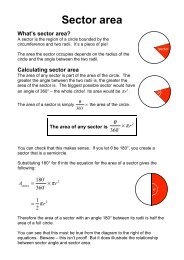
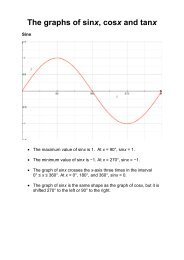
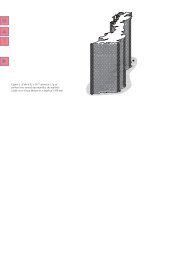
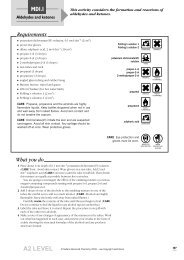
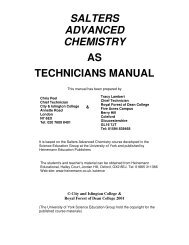



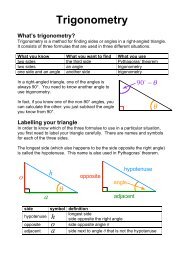
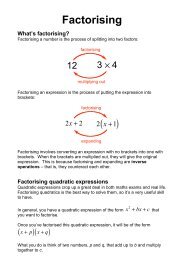
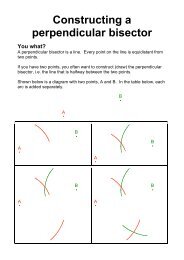

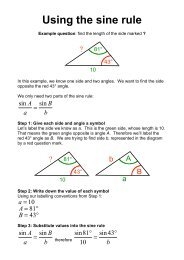
![ISI Web of Knowledge [v.4.10] - All Databases Results - Benjamin-Mills](https://img.yumpu.com/39253071/1/184x260/isi-web-of-knowledge-v410-all-databases-results-benjamin-mills.jpg?quality=85)